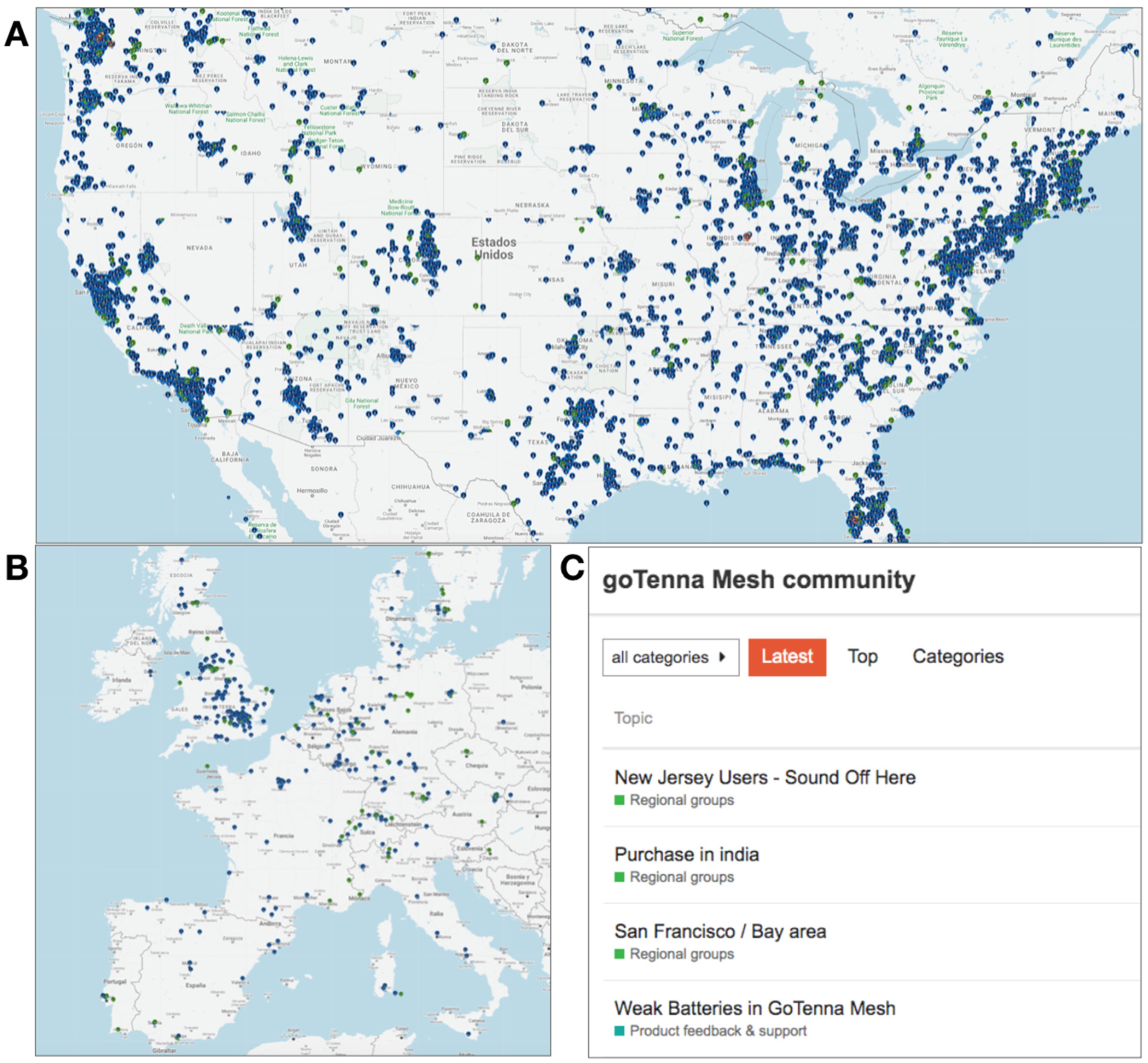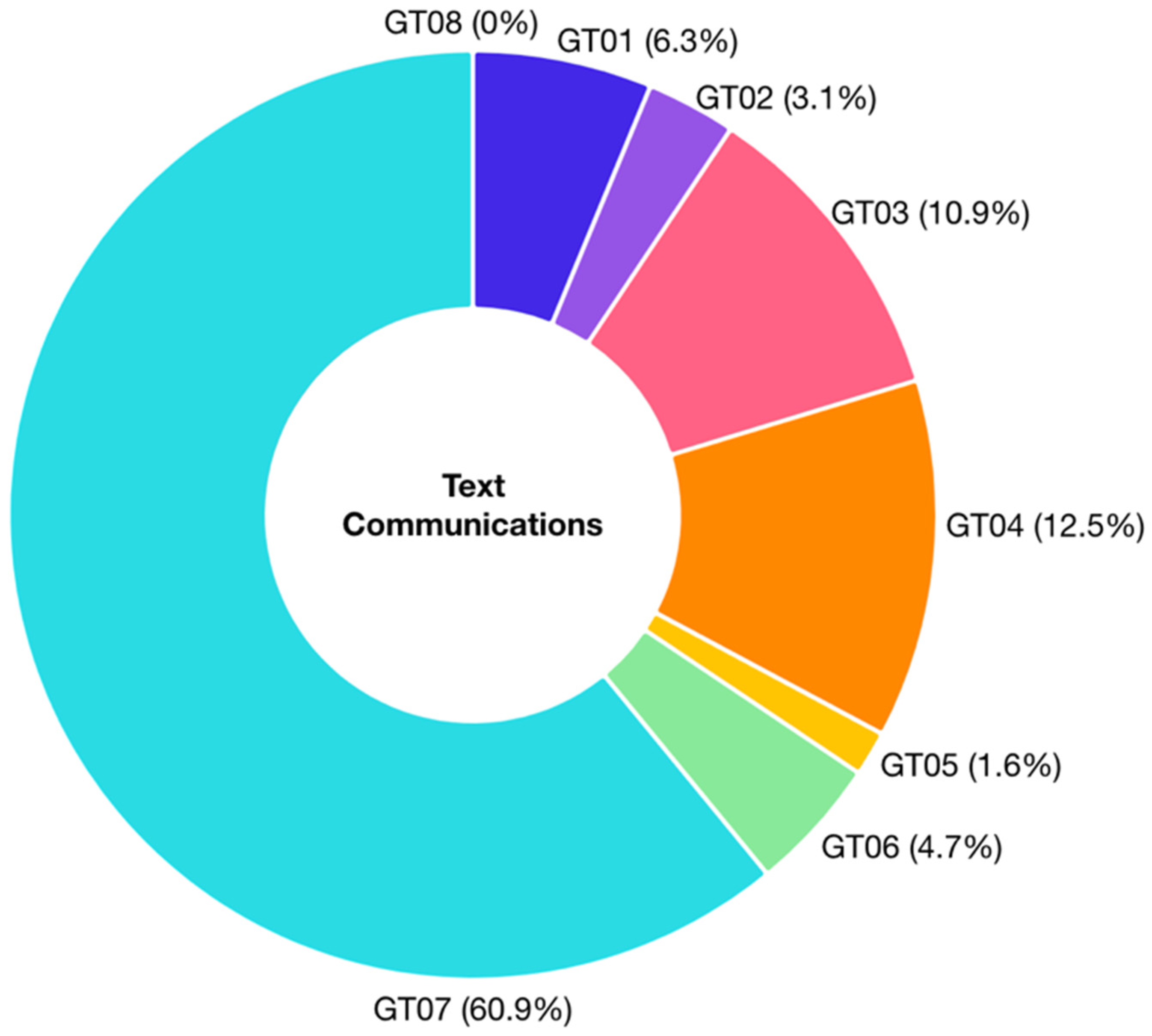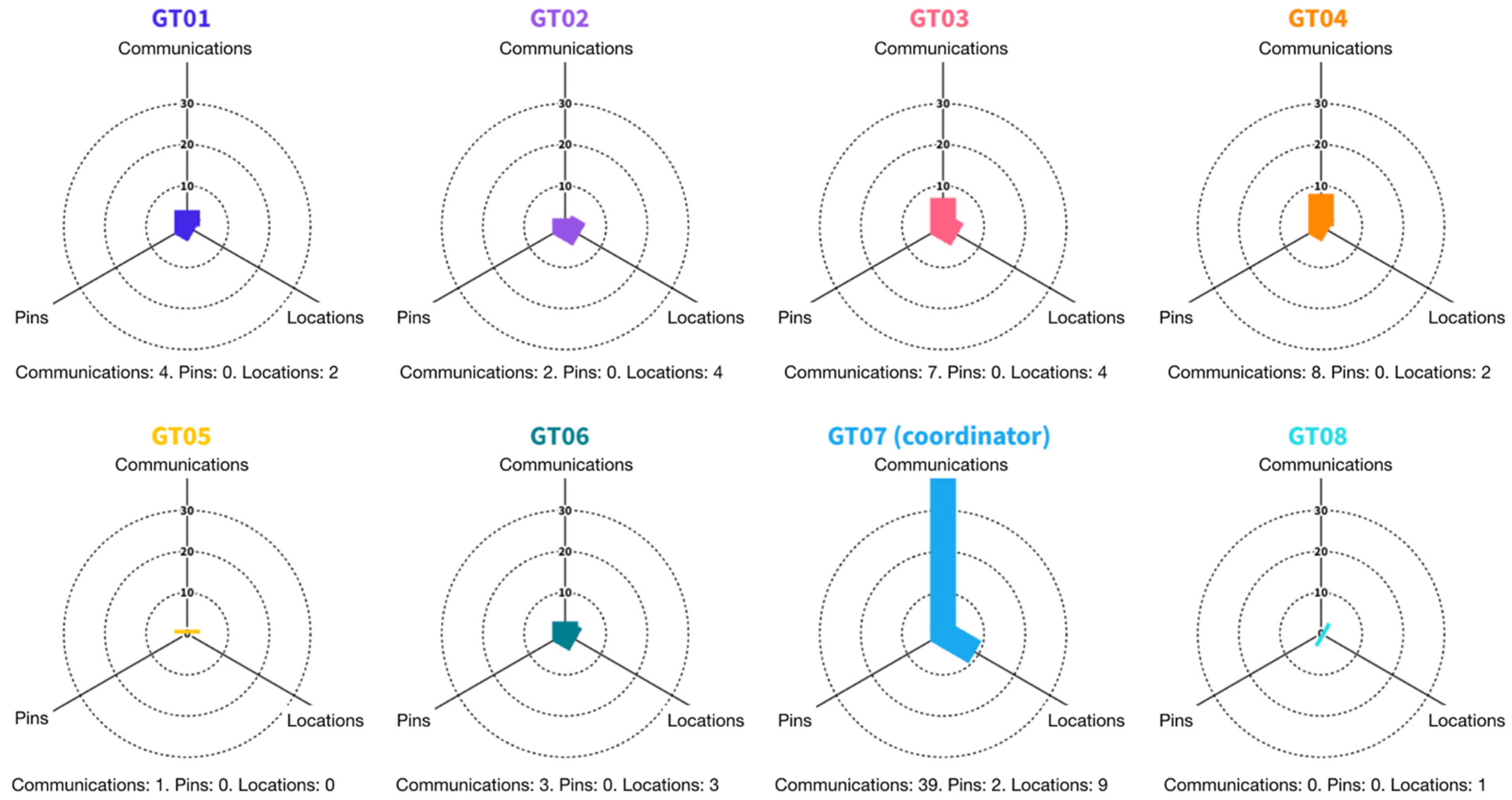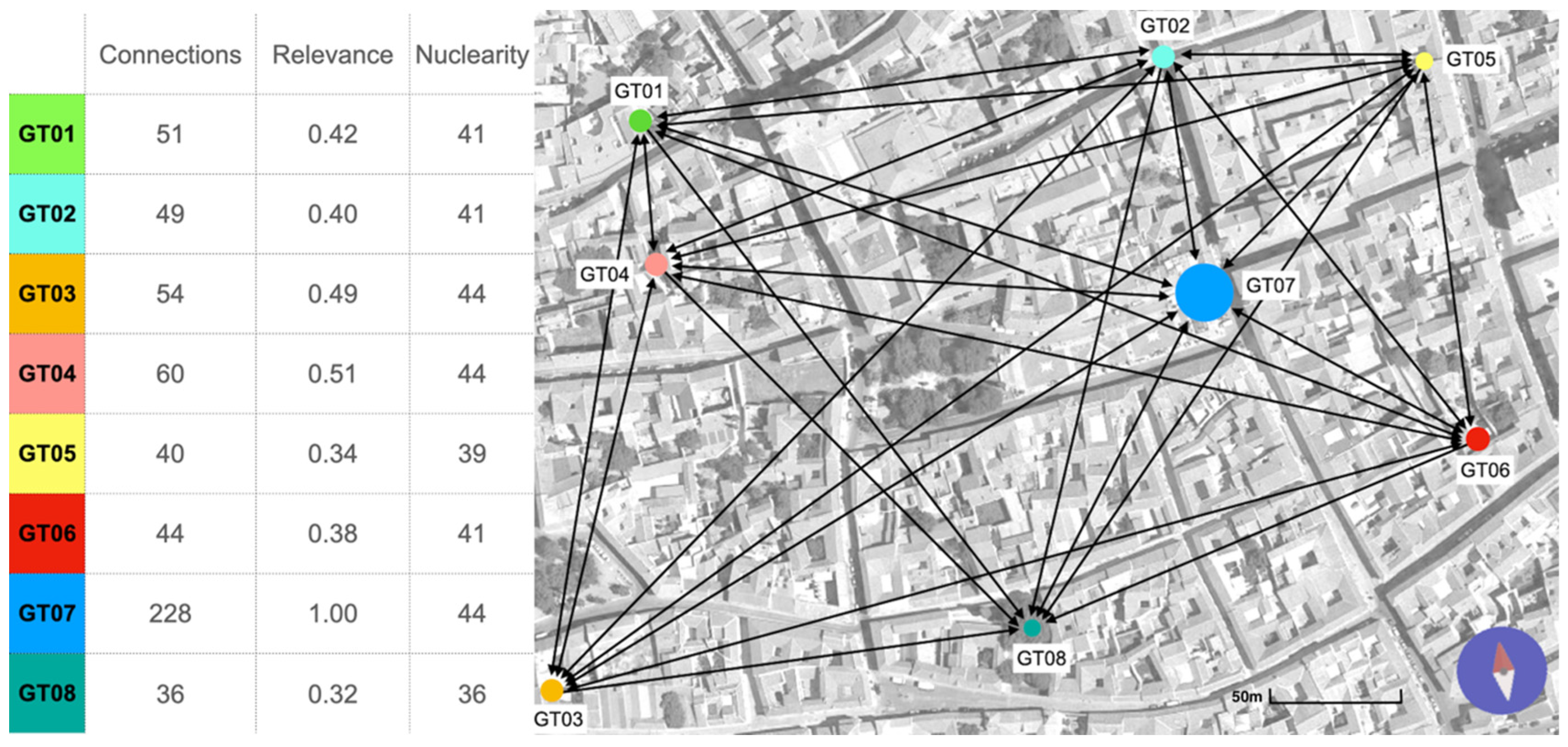Practical Application of Mesh Opportunistic Networks
Abstract
1. Introduction
- RQ1. What are the benefits and limitations of mesh OppNets in one-to-one communication compared with current alternatives?
- RQ2. Can mesh OppNets be used for successful group communications?
- RQ3. Can mesh OppNets be integrated in a professional communication workflow?
2. Theoretical Background
2.1. Opportunistic Networks or OppNets
2.2. The Coverage and Scope of the Mesh OppNets
2.3. Privacy and Security in Mesh OppNets
2.4. OppNets and Broadcasters
3. Materials and Methods
3.1. Participants
3.2. Mesh Communication Devices
3.3. Mobile Devices
3.4. Range of the Devices
3.5. The Experimental Session
3.6. Analysis
3.6.1. Survey
3.6.2. Focus Group
3.6.3. Communication Flow among Participants
3.6.4. Video Uploads Made by Participants
4. Results
4.1. Survey
4.1.1. One-to-One Communication
4.1.2. Group Communication
4.1.3. Use of Localization Tools Integrated into the Communication Flow
4.2. Focus Group
4.3. Communication Flow among Participants
4.3.1. Communications, Locations and Pins
4.3.2. Connections, Relevance and Nuclearity (K-Index)
4.4. Videos Uploaded by the Participants
5. Discussion
5.1. Mesh OppNets in One-to-One Communication
5.2. Mesh OppNets in Group Communications
5.3. Mesh OppNets in Professional Communication Workflows
5.4. Mesh OppNets as an Emergent Technology in Future Smart City
Author Contributions
Funding
Data Availability Statement
Acknowledgments
Conflicts of Interest
References
- Kwasinski, A. Effects of Hurricanes Isaac and Sandy on Data and Communications Power Infrastructure. In Proceedings of the Intelec 2013 35th International Telecommunications Energy Conference, Smat Power and Efficiency, Hamburg, Germany, 13–17 October 2013; pp. 1–6. [Google Scholar]
- Federal Communications Commission. Communications Status Report for Areas Impacted by Hurricane Dorian; Federal Communications Commission: Washington, DC, USA, 2019. [Google Scholar]
- Mayo-Cubero, M. Uso de las redes sociales en la cobertura periodística de crisis, desastres y emergencias en España. Rev. Esp. Comun. Salud 2019, (Suppl. 1), 43–54. [Google Scholar] [CrossRef]
- Stephens, K.K.; Robertson, B.W.; Murthy, D. Throw me a lifeline: Articulating mobile social network dispersion and the social construction of risk in rescue communication. Mob. Media Commun. 2020, 8, 149–169. [Google Scholar] [CrossRef]
- Ferranti, L.; Oro, S.D.; Bonati, L.; Demirors, E.; Cuomo, F.; Melodia, T. HIRO-NET: Self-Organized Robotic Mesh Networking for Internet Sharing in Disaster Scenarios. In Proceedings of the 2019 IEEE 20th International Symposium on “A World of Wireless, Mobile and Multimedia Networks” (WoWMoM), Washington, DC, USA, 10–12 June 2019. [Google Scholar]
- Lilien, L.; Kamal, Z.H.; Bhuse, V.; Gupta, A. The concept of opportunistic networks and their research challenges in privacy and security. In Mobile and Wireless Network Security and Privacy; Makki, S.K., Teiher, P., Makki, K., Pissinou, N., Makki, S., Eds.; Springer: Boston, MA, USA, 2007; pp. 85–117. [Google Scholar]
- Lilien, L.; Gupta, A.; Yang, Z. Opportunistic networks for emergency applications and their standard implementation framework. In Proceedings of the 2007 IEEE International Performance, Computing, and Communications Conference, New Orleans, LA, USA, 11–13 April 2007. [Google Scholar]
- Borrego, C.; Borrell, J.; Robles, S. Efficient broadcast in opportunistic networks using optimal stopping theory. Ad Hoc Netw. 2019, 88, 5–17. [Google Scholar] [CrossRef]
- Borrego, C.; Borrell, J.; Robles, S. Hey, influencer! Message delivery to social central nodes in social opportunistic networks. Comput. Commun. 2019, 137, 81–91. [Google Scholar] [CrossRef]
- Cuka, M.; Elmazi, D.; Bylykbashi, K.; Matsuo, K.; Ikeda, M.; Barolli, L. A Fuzzy-Based System for Selection of IoT Devices in Opportunistic Networks Considering Number of Past Encounters. In Advances on P2P, Parallel, Grid, Cloud and Internet Computing; Xhafa, F., Leu, F.-Y., Ficco, M., Yang, C.-T., Eds.; Springer Nature AG: Cham, Switzerland, 2019; pp. 223–237. [Google Scholar]
- Cardoso, G. Los Medios de Comunicación en la Sociedad en Red. Filtros, Escaparates y Noticias; UOC Ediciones: Barcelona, Spain, 2008. [Google Scholar]
- Frith, J.; Özkul, D. Mobile media beyond mobile phones. Mob. Media Commun. 2019, 7, 293–302. [Google Scholar] [CrossRef]
- TripSavvy. Available online: https://www.tripsavvy.com/gadgets-for-backcountry-communication-4066040 (accessed on 16 March 2022).
- Fundación Telefónica. Identidad Digital: El Nuevo Usuario en el Mundo Digital; Fundación Telefónica: Barcelona, Spain, 2013. [Google Scholar]
- Solove, D.J. The Digital Person: Technology and Privacy in the Information Age; New York University Press: New York, NY, USA, 2004. [Google Scholar]
- Enriquez, J. As the Future Catches You: How Genomics and Other Forces Are Changing Your Life, Work, Health, and Wealth; Random House Inc.: New York, NY, USA, 2001. [Google Scholar]
- Enriquez, J. Your Online Life, Permanent as a Tattoo. Ted Talk 2013. Available online: https://www.youtube.com/watch?v=Fu1C-oBdsMM (accessed on 16 March 2022).
- Setyowati, L. Digital Life, Digital Tattoo and the Filter Bubble: Raising the awareness and the cautions on online activities through information literacy education. In Proceedings of the International Conference on Science Mapping and the Development of Science, Gadjah Mada University, Yogya, Indonesia, 20–21 April 2016. [Google Scholar]
- Castells, M. Redes de Indignación y Esperanza; Alianza Editorial: Madrid, Spain, 2012. [Google Scholar]
- Díaz Revorio, F.J. Los Derechos Humanos ante Los Nuevos Avances Científicos y Tecnológicos. Genética e Internet ante la Constitución; Tirant Lo Blanch: Valencia, Spain, 2009. [Google Scholar]
- Pérez Luño, A.E. Nuevas Tecnologías y Derechos Humanos; Tirant Lo Blanch: Valencia, Spain, 2014. [Google Scholar]
- In the Mesh. Available online: https://inthemesh.com/archive/the-eye-of-sauron-problem/ (accessed on 16 March 2022).
- Lightning Network. Available online: https://lightning.network/lightning-network-paper.pdf (accessed on 16 March 2022).
- Global Mesh Labs. Available online: https://acortar.link/7ek1HQ (accessed on 16 March 2022).
- Arora, S.; Barton, J.; Judd, B.; Wang, D. Peer-3-Peer: Disaster Proof Offline Messaging; Integration Lab at University of Pennsylvania: Philadelphia, PA, USA, 2019; pp. 1–9. [Google Scholar]
- Martín-Pascual, M.Á.; Andreu-Sánchez, C. La eclosión de la técnica ubicua. In #MOJO: Manual de Periodismo Móvil; Pérez Tornero, J.M., Martín-Pascual, M.Á., Eds.; Instituto RTVE: Madrid, Spain, 2017; pp. 63–92. [Google Scholar]
- Garcia Garcia, L. Diseño y Análisis de un Sistema de Inhibición de Frecuencia Portátil en un Entorno Inalámbrico Interior. Ph.D. Thesis, Public University of Navarra, Navarra, Spain, 2014. [Google Scholar]
- ITU—International Telecommunication Union. Available online: https://www.itu.int/pub/R-REG-RR-2016 (accessed on 16 March 2022).
- Perdomo, J. System and Method for Private and Point-to-Point Communication between Computing Devices. U.S. Patent No. 10,164,776 B1, 4 June 2018. [Google Scholar]
- Perdomo, J. System and Method for Digital Communication between Computing Devices. U.S. Patent No. 10,015,720 B2, 16 March 2015. [Google Scholar]
- Techcrunch. Available online: https://acortar.link/1kR4qw (accessed on 16 March 2022).
- Crain’s New York Business. Available online: https://www.crainsnewyork.com/technology/gotenna-helps-first-responders-stay-connected-harshest-conditions (accessed on 16 March 2022).
- World Economic Forum. Available online: https://www.weforum.org/press/2019/07/meet-the-2019-world-economic-forum-technology-pioneers/ (accessed on 16 March 2022).
- Onodo. Available online: https://onodo.org/ (accessed on 16 March 2022).
- Seligman, M.E.P. Flourish; Simon & Schuster: New York, NY, USA, 2013. [Google Scholar]
- Schnauber-Stockmann, A.; Karnowski, V. Mobile Devices as Tools for Media and Communication Research: A Scoping Review on Collecting Self-report Data in Repeated Measurement Designs. Commun. Methods Meas. 2020, 14, 145–164. [Google Scholar] [CrossRef]
- Liu, D.; Huang, K.; Hu, Q.; Wu, S. Node importance measurement and simulation of complex network based on k-index expansion. In Proceedings of the IEEE 5th International Conference on Automation, Control and Robots (ICACR), Nanning, China, 25–27 September 2021; pp. 43–49. [Google Scholar]
- Trifunovic, S.; Distl, B.; Plattner, B.; Kouyoumdjieva, S.T.; Pajevic, L.; Karlsson, G. A decade of research in opportunistic networks: Challenges, relevance, and future directions. IEEE Commun. Mag. 2017, 55, 168–173. [Google Scholar] [CrossRef]
- Liu, K.; Shen, W.; Yin, B.; Cao, X.; Cai, L.X.; Cheng, Y. Development of mobile ad-hoc networks over Wi-Fi direct off-the-shelf Android phones. In Proceedings of the IEEE ICC 2016 Ad-Hoc and Sensor Networking Symposium, Kuala Lumpur, Malaysia, 22–27 May 2016; p. 16142417. [Google Scholar]






| Time | Type | GT Sender | GT Receiver |
|---|---|---|---|
| 6:42 | Text | 1 | Everyone |
| 6:43 | Text | 7 | Everyone |
| 6:43 | Text | 4 | Everyone |
| 6:43 | Text | 1 | Everyone |
| 6:43 | Text | 4 | Everyone |
| 6:43 | Text | 3 | Everyone |
| 6:43 | Text | 5 | Everyone |
| 6:44 | Text | 6 | Everyone |
| 6:44 | Text | 2 | Everyone |
| 7:06 | Text | 7 | Everyone |
| 7:07 | Location | 7 | Everyone |
| 7:07 | Text | 7 | Everyone |
| 7:07 | Text | 3 | 7 |
| 7:08 | Text | 7 | 3 |
| 7:08 | Location | 3 | 7 |
| 7:09 | Text | 7 | 3 |
| 7:09 | Text | 3 | 7 |
| 7:09 | Text | 3 | 7 |
| 7:09 | Text | 7 | 3 |
| 7:09 | Location | 7 | Everyone |
| 7:10 | Text | 7 | Everyone |
| 7:12 | Location | 2 | Everyone |
| 7:17 | Text | 7 | Everyone |
| 7:17 | Text | 7 | Everyone |
| 7:18 | Text | 7 | Everyone |
| 7:19 | Text | 4 | 7 |
| 7:19 | Text | 7 | 4 |
| 7:19 | Location | 7 | 4 |
| 7:19 | Text | 4 | 7 |
| 7:19 | Text | 7 | 4 |
| 7:21 | Text | 2 | 7 |
| 7:21 | Text | 3 | 7 |
| 7:21 | Text | 7 | Everyone |
| 7:22 | Location | 3 | 7 |
| 7:23 | Location | 7 | Everyone |
| 7:23 | Text | 1 | 7 |
| 7:23 | Location | 1 | 7 |
| 7:24 | Text | 7 | 1 |
| 7:25 | Text | 7 | 2, 4 and 8 |
| 7:25 | Location | 2 | 7 |
| 7:25 | Text | 7 | 2 |
| 7:26 | Text | 4 | 7 |
| 7:26 | Text | 7 | Everyone |
| 7:29 | Location | 4 | 7 |
| 7:30 | Text | 7 | 4 |
| 7:30 | Location | 7 | Everyone |
| 7:30 | Text | 7 | 6 and 8 |
| 7:31 | Text | 6 | 7 |
| 7:32 | Text | 7 | 6 |
| 7:32 | Location | 6 | 7 |
| 7:32 | Location | 7 | Everyone |
| 7:32 | Text | 4 | 7 |
| 7:32 | Location | 4 | 7 |
| 7:33 | Text | 7 | 4 |
| 7:40 | Text | 3 | 7 |
| 7:40 | Location | 3 | 7 |
| 7:41 | Text | 7 | Everyone |
| 7:42 | Location | 2 | 7 |
| 7:43 | Location | 2 | 7 |
| 7:46 | Text | 1 | 7 |
| 7:46 | Location | 1 | 7 |
| 7:51 | Text | 6 | 7 |
| 7:51 | Location | 6 | 7 |
| 7:52 | Text | 7 | 6 |
| 7:52 | Location | 7 | Everyone |
| 7:52 | Text | 7 | 4 |
| 7:52 | Text | 7 | 2 |
| 7:52 | Text | 7 | 1 |
| 7:53 | Text | 7 | 6 |
| 7:53 | Text | 7 | 5 |
| 7:53 | Text | 7 | 8 |
| 7:54 | Text | 7 | Everyone |
| 7:53 | Location | 6 | 7 |
| 7:55 | Text | 7 | 6 |
| 7:56 | Location | 3 | 7 |
| 7:57 | Text | 7 | Everyone |
| 7:58 | Text | 7 | Everyone |
| 7:59 | Text | 7 | 3 |
| 8:00 | Text | 7 | Everyone |
| 8:00 | Location | 7 | Everyone |
| 8:01 | Text | 4 | 7 |
| 8:01 | Text | 4 | 7 |
| 8:02 | Text | 7 | 4 |
| 8:09 | Text | 7 | Everyone |
| 8:11 | Pins | 7 | Everyone |
| 8:14 | Text | 7 | Everyone |
| 8:14 | Location | 7 | Everyone |
| 8:20 | Text | 3 | 7 |
| 8:21 | Text | 7 | 3 |
Disclaimer/Publisher’s Note: The statements, opinions and data contained in all publications are solely those of the individual author(s) and contributor(s) and not of MDPI and/or the editor(s). MDPI and/or the editor(s) disclaim responsibility for any injury to people or property resulting from any ideas, methods, instructions or products referred to in the content. |
© 2023 by the authors. Licensee MDPI, Basel, Switzerland. This article is an open access article distributed under the terms and conditions of the Creative Commons Attribution (CC BY) license (https://creativecommons.org/licenses/by/4.0/).
Share and Cite
Martín-Pascual, M.Á.; Andreu-Sánchez, C. Practical Application of Mesh Opportunistic Networks. Appl. Syst. Innov. 2023, 6, 60. https://doi.org/10.3390/asi6030060
Martín-Pascual MÁ, Andreu-Sánchez C. Practical Application of Mesh Opportunistic Networks. Applied System Innovation. 2023; 6(3):60. https://doi.org/10.3390/asi6030060
Chicago/Turabian StyleMartín-Pascual, Miguel Ángel, and Celia Andreu-Sánchez. 2023. "Practical Application of Mesh Opportunistic Networks" Applied System Innovation 6, no. 3: 60. https://doi.org/10.3390/asi6030060
APA StyleMartín-Pascual, M. Á., & Andreu-Sánchez, C. (2023). Practical Application of Mesh Opportunistic Networks. Applied System Innovation, 6(3), 60. https://doi.org/10.3390/asi6030060




